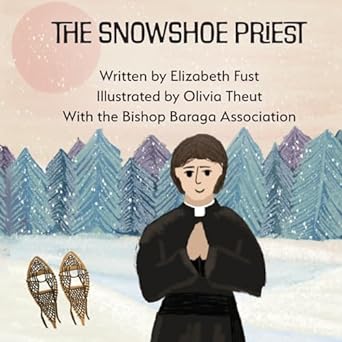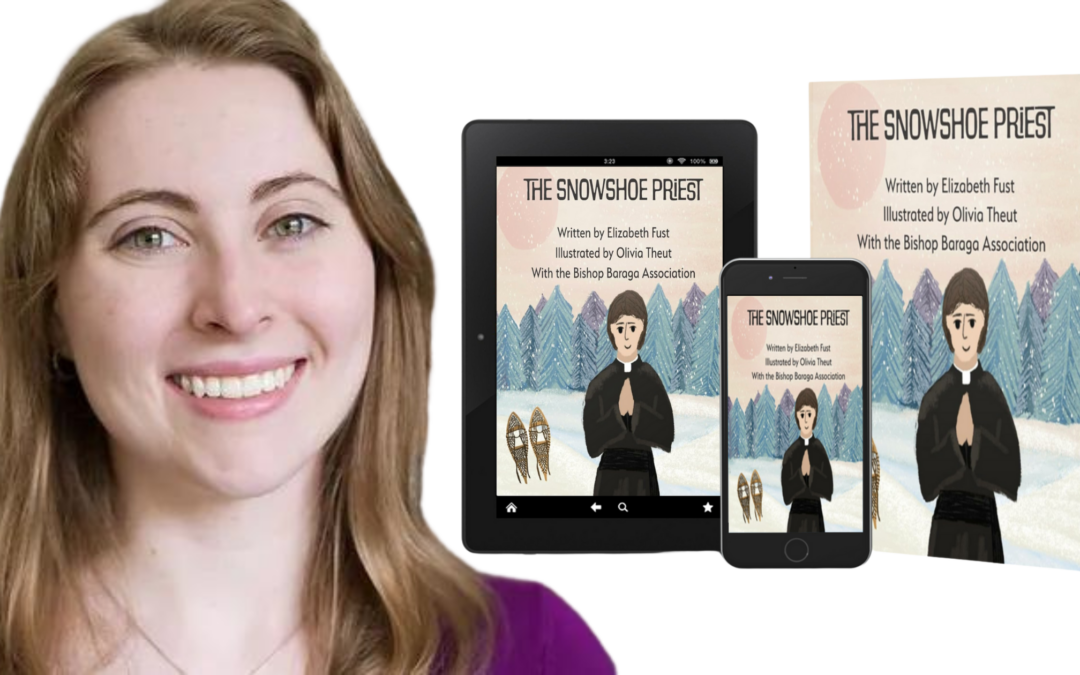Book Review: The Snowshoe Priest by Elizabeth Fust
Michigan’s Catholic History
 If you ever visit the city of Marquette in Michigan’s Upper Peninsula, make sure you stop by St. Peter’s Cathedral. Originally built in 1864, the impressive Romanesque structure is made of sandstone and features impressive marblework throughout the interior. Significantly, the design was done by Corrado Parducci, a renowned 19th-century Italian-American architect. The cathedral is a beautiful edifice and is a state-designated historic landmark. It is absolutely worth a day trip to explore. I have personally visited the cathedral many times and always find solace in its elegant adoration chapel.
If you ever visit the city of Marquette in Michigan’s Upper Peninsula, make sure you stop by St. Peter’s Cathedral. Originally built in 1864, the impressive Romanesque structure is made of sandstone and features impressive marblework throughout the interior. Significantly, the design was done by Corrado Parducci, a renowned 19th-century Italian-American architect. The cathedral is a beautiful edifice and is a state-designated historic landmark. It is absolutely worth a day trip to explore. I have personally visited the cathedral many times and always find solace in its elegant adoration chapel.
The cathedral has a bishops’ crypt in the basement where visitors can go down and see the tombs of Marquette’s ordinaries going back to the founding of the diocese in 1853. One bishop’s tomb stands apart from the rest in a separate side chapel to the right of the sanctuary, that of Ven. Bishop Frederic Baraga. Frederic Baraga (1797-1868) was the first Bishop of Marquette and a famous Great Lakes missionary. He was known as the “Snowshoe Priest” because of his missionary travels by foot through the harsh winter terrain of the Upper Peninsula (U.P.). Significantly, Baraga established the Church in the greater Marquette region. His cause was opened in 1952, and Benedict XVI declared him venerable in 2012.
Venerable Bishop Frederic Baraga
The cause of Baraga is promoted by the Bishop Baraga Association. The Association has recently published a children’s book called The Snowshoe Priest to raise awareness about Bishop Baraga and promote his cause. The Snowshoe Priest was written by Elizabeth Fust, a Michigan children’s author and lover of the history and culture of the Upper Peninsula. The illustrations were done by Olivia Theut, also a local artist.
Personally, I have always loved Bishop Baraga and wished there were more resources for this extraordinary man. I was thrilled, therefore, to pick up a copy of The Snowshoe Priest. At 35 pages, The Snowshoes Priest is just the right length for young readers to learn about the life of the venerable missionary. The book takes the reader through the life and trials of Baraga, beginning with his childhood in Slovenia and his call to the priesthood. We learn about his interest in the American missions, his coming to the United States in 1830, his missionary work among the Ojibwe of the U.P., and his work to build up the Church in northern Michigan.
There are also some fun stories about specific episodes from Baraga’s life—the time he got lost in the snow and almost froze to death, the time he attended the wedding of Emperor Franz Josef of Austria, the time he traveled back to Europe to raise money for his missionary work, etc.
A Slovenian Catholic Missionary to Native Americans
I particularly appreciated the book’s devotion to Baraga’s work with the Ojibwe people. Most of Baraga’s missionary labor was among the Ojibwe, and his relationship with them was central to his work. There was a fruitful cultural exchange between Baraga and the Ojibwe. Baraga built schools for them, taught English, and ministered to their needs. The Ojibwe loved Baraga and helped him build his churches. They carried him around the U.P. in their canoes and taught him to use the Ojibwe show shoes that allowed him to walk atop the thick snow. This is how he earned his famous nickname. Baraga created an Ojibwe dictionary that would be of tremendous use to future missionaries.
Although it’s not mentioned in the book, it is also noteworthy that Baraga kept detailed journals of his missionary work published in Europe. These journals were instrumental in bringing other missionaries to the United States. Most notable of these are St. John Neumann and Francis Xavier Pierz, the father of the Diocese of Saint Cloud, Minnesota.
Elizabeth also goes to great lengths to portray God’s love as the great motivation behind Baraga’s work. He was sincerely driven by a supernatural charity for the good of his flock. His great wish was to share the love of Christ with the native people and build up God’s kingdom in the snowy north.
Great Picture Book for Your Home Library
The illustrations by Olivia Theut are simple yet powerful. The characters have a cartoonish look, which is perfect given the book’s age range. Thus, I’d say the book is at the elementary level. Notably, it is with the landscapes that Theut’s illustrations really shine. Whether depicting the wildflower-strewn pastures of the U.P., the reddish sandstone of St. Peter’s Cathedral, or the snowy woods of the north, Theut captures the aesthetic of the Upper Peninsula vividly. She even gets the particular blue hue of Lake Superior correct. This is a Michigander thing, but those of us who love Lake Superior know its blueness is very particular. It is an aquamarine or teal, sometimes almost greenish in appearance. I smiled when I saw it. Consequently, it made me want to head north and retread the paths taken by Bishop Baraga in the olden days.
Furthermore, the book contains some fun Easter eggs. Seven animals are hidden throughout the illustrations that children can look for as they reread. Undeniably, I found this to be a nice touch.
Conclusion
I liked The Snowshoe Priest. It is admittedly simple, but that’s all it needs to be. It was refreshing to see a book highlighting Bishop Baraga’s truly heroic work in an age where it has become sadly fashionable to dwell on clergy failures. This book could also be incorporated into an elementary school lesson on North American missionaries and the interactions between the Church and Native Americans.
Another fun fact: In messaging with Elizabeth Fust, I learned that she is a Homeschool Connections alumnus! How cool is that? What a small Catholic world it is.
Here are some of Elizabeth’s other published picture books:
You can follow Elizabeth on Facebook or visit her website at Elizabeth Fust Books.
Do you have great picture books to share? I invite you to join me and other Catholic homeschooling parents at our Homeschool Connections Community or our Facebook group. We’d love to hear about your favorite living literature resources and homeschool tips!
This article contains affiliate links.






